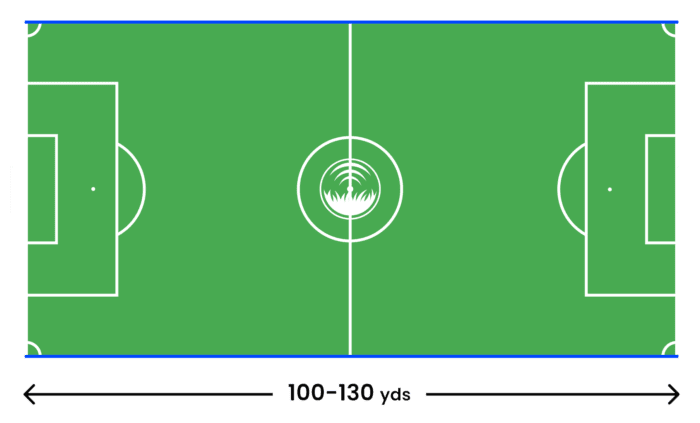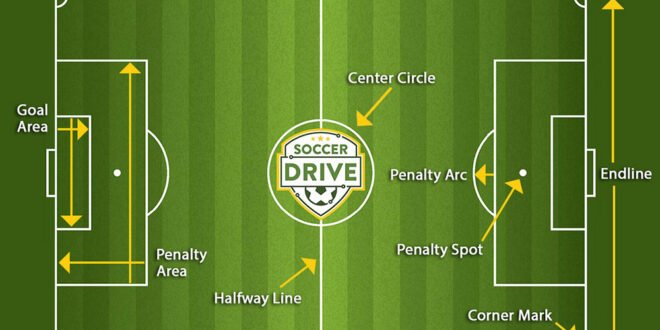Lines on a soccer field designate the boundaries and areas of play. They include sidelines, end lines, a center circle, and goal boxes.
Soccer, known globally as football, is played on a rectangular field marked with distinctive lines. These lines define key areas such as the halfway line, which divides the field into two halves, and the penalty area, crucial for determining fouls and goalkeeping rights.
The center spot and circle set the stage for kick-offs, while the corner arcs are essential for corner kicks. A soccer field’s dimensions and line markings are standardized to maintain consistency in gameplay. Understanding these lines is fundamental for players, referees, and enthusiasts, as they dictate the rules and flow of the game. By familiarizing oneself with the layout of a soccer field, one gains a deeper appreciation for the strategic complexity of this beloved sport.
🔴Lines on Soccer Field🔴

Table of Contents
The Essence Of Lines In Soccer
Soccer fields come to life through their lines. These lines are more than mere markings. They define the game, set the stage for all the magic that happens during a match. Now, let’s delve into how these lines maintain order and excitement on the pitch.
Catalysts Of Fair Play
Lines on a soccer field serve as strict guardians of fairness. They mark boundaries and zones, ensuring every player knows the limits. This precision prevents disputes and supports refs in making accurate calls. Imagine a game without them; chaos would rein!
- Boundary Lines: Keep the ball inside the playing area.
- Penalty Areas: Determine where goalies can handle the ball and where fouls become penalties.
- Centre Line: Balances team positions at kickoff.
Guiding The Flow Of The Game
Like invisible guides, these lines shape player movement and strategies. The pitch’s geometry encourages creative play patterns. It’s a chessboard where every move is informed by these crucial lines.
| Line | Function |
|---|---|
| Touch Lines | Control the sideline movement. |
| Goal Lines | Focus attacks toward the nets. |
| Penalty Spot | Spot-kicks influence scoring opportunities. |
Breaking Down The Soccer Pitch
In the game of soccer, every line on the pitch plays a crucial role. A well-defined soccer pitch not only sets the stage for the game but also defines the parameters within which the players exhibit their skills. Let’s take a closer look at the soccer field, examining its dimensions, markings, and how they can vary across different leagues.
Dimensions And Markings
A standard soccer pitch includes several key features:
- Touchlines: These are the longest lines on the field, defining its length.
- Goal lines: They demarcate the width of the pitch and the front of the goal.
- Centre circle: A 9.15m radius circle for kickoff.
- Penalty box: It’s a box in front of each goal, for penalty kicks.
- Corner arcs: These are small quarter-circles from each corner.
Recommended dimensions for a soccer pitch:
| Feature | Dimension |
|---|---|
| Length | 100 to 110 meters |
| Width | 64 to 75 meters |
Variability Across Leagues
The size of a soccer field isn’t the same everywhere. The regulations might differ depending on the league or level of play.
- FIFA: Sets the international standard for professional games.
- UEFA: Follows similar standards but allows for minor variations.
- Youth Soccer: Smaller fields to accommodate younger players.
FIFA’s Laws of the Game specify a range for field dimensions, offering flexibility to accommodate different venues and levels of play. Fields must adhere to this range:
| Level | Length | Width |
|---|---|---|
| Professional | 100 to 110m | 64 to 75m |
| Youth | Varies | Varies |
The End Lines: Goals And Beyond
In the world of soccer, the end lines signify much more than mere boundaries. These lines serve as the gateways to triumph and the heralds of critical in-game events. Let’s delve into the pivotal role these lines play, shaping the very essence of the game.
Defining The Game’s Objective
The principal aim of soccer circles around the end lines, namely scoring goals. Positioned at each end of the pitch, they delineate where teams can earn points by driving the ball into the opposing net. This action defines victory and defeat, making end lines crucial to the game’s core.
What Happens When The Ball Crosses
Crossing the end lines prompts action. Let’s break down what occurs:
- Goal: When a player knocks the ball across the opposition’s goal line and into the net, their team is awarded a point.
- Goal Kick: If the attacking team sends the ball past the goal line without scoring, the defending team gets to restart the play from their goal area.
- Corner Kick: If the defending team is the last to touch the ball before it crosses their goal line without a score, the attacking team secures a corner kick, a prime opportunity to score.
This clear-cut flow dictates match momentum, keeps players alert, and excites fans. The rules applied when the ball crosses these end lines are simple yet pivotal for the sport’s excitement and fairness.

Sidelines: The Boundary Of Play
Imagine watching a soccer game without knowing where the ball can go. The sidelines give us that knowledge. They mark the game’s boundaries. Players must keep the ball inside these lines to continue the match.
Keeping The Game In Check
The sidelines are crucial to soccer’s rules. They run the length of the field. They ensure fair play by marking the edges. If the ball crosses these lines, play stops. This helps referees control the game. A match without sidelines would be chaos.
Throw-ins And Restarting Play
When the ball goes out of bounds, it’s time for a throw-in. This act restarts the game. Only hands are used for throw-ins, not feet. The player throwing the ball must have both feet on the ground. The ball must go over their head. This is one of the ways play continues within the boundaries.
The Center Circle And Kick-off
The center circle on a soccer field is where the excitement begins. In soccer, teams clash to score goals and cheer crowds. The center circle plays a big role in starting the game. Here, we look closer at this special area. This circle keeps teams fair at kick-off.
Starting And Restarting The Match
The match begins with a kick-off from the center circle. The referee blows the whistle, and the ball rolls into play. The starting kick-off happens after teams win the coin toss. Teams swap sides and restart the game in the second half. Kick-offs also restart play after goals.
- The referee starts the game with the whistle
- coin toss decides the first kick-off
- Teams switch sides in the second half
- After a goal, kick-off restarts the match
The Circle Of Neutrality
The center circle sets space for fairness. It’s 10 yards wide, keeping teams apart. During kick-off, only the kicker is in the circle. Other players wait outside until the ball is in play. This rule lets the kicking team start without pressure.
| Circle Diameter | 20 yards (10-yard radius) |
|---|---|
| Players Inside During Kick-Off | Only the kicker |
| Player Position | Others outside the circle |
| Kick-Off Rule | No pressure on the kicker |
This space is key for a fair start. Fans see their favorite teams kick off in this circle. It’s also where the second half sparks back into action. Remember, the center circle is for fairness and fun.
The Penalty Box: A Zone Of Consequence
Soccer fields hold many critical zones, but few can change a game like the penalty box. This area is a hotspot for game-altering events. Known technically as the penalty area, this zone decides team fates. It’s where nerves kick in, and players become heroes or scapegoats. Every soccer fan’s eyes often lock on this box, as it hosts moments that can lead to noisy stadiums or silent awe.
Decoding The 18-yard Box
The 18-yard box is key to understanding soccer rules. Measuring precisely 18 yards from the goal line, its importance is unmatched. This box is soccer’s own ‘room of decision’ where goalkeepers can handle the ball and fouls can turn into penalties. The dimensions are always the same:
- Length: 44 yards across the field
- Width: 18 yards out from the goal line
Inside, several lines and markings play special roles. The smaller rectangle within, the 6-yard box, is where goal kicks start. Understanding the 18-yard box helps fans and players alike anticipate the game’s flow.
Penalties And High-stakes Moments
In the penalty box, fouls can lead to penalties, changing the course of the match. It’s not just a place; it’s a drama-filled moment waiting to happen. Here’s what triggers a penalty:
| Event | Consequence |
|---|---|
| Defensive foul | Penalty kick awarded |
| Handball | Free kick or penalty kick |
| Offenses by attackers | Free kick to the defending team |
During a penalty kick, the stadium buzzes with tension. Each penalty kick can be a make-or-break moment for the teams involved. Strikers aim to score, while goalkeepers focus on saving. Fans hold their breath, knowing these high-stakes moments are what make the sport thrilling.
The Six-yard Box: Close-range Dynamics
The pitch markings on a soccer field are more than just random lines. They guide the flow of the game. The six-yard box, also known as the goal area, is critical. Here we discuss why this small rectangle is so vital to the sport’s dynamics.
Goalkeeper’s Domain
In the soccer world, the six-yard box is the goalkeeper’s territory. This zone marks their reign. Within these lines, a keeper can pick up the ball. It offers a safe zone for performing their duty. Here’s what this domain involves:
- Quick reflex saves: Keepers often make split-second decisions here.
- Command over area: Goalkeepers use this box to guard against threats.
- Goal kicks: They are taken from within this rectangle of power.
Concentrated Action During Set Plays
The six-yard box is most intense during corners and free kicks. Here’s how it influences the match:
| Set Plays | Role of the Six-Yard Box |
|---|---|
| Corners | Aim for chaos, keepers fight to punch the ball away. |
| Free Kicks | Defenders and attackers jostle for the ball. |
Players crowd this area, and any touch can change the game’s outcome. The six-yard box is a hotbed for dramatic goals and vital saves.
Touchline Dynamics: Impacts On Play
The dynamics of the touchline on a soccer field often go unnoticed. Yet, they affect how the game unfolds. Let’s delve into how touchlines influence play and strategies in soccer.
Interactions With Players And Officials
Touchlines define the game’s playing field. Players must keep the ball within these lines. If the ball crosses a touchline, play stops. Teams can gain a tactical edge by using the touchline’s boundaries during play. Here are key touchline interactions:
- Throw-ins: When the ball crosses the touchline, teams resume play with a throw-in.
- Officiating: Referees and assistants watch these lines closely to make calls.
- Player Positions: Wingers and full-backs often hover near touchlines to create width.
Strategic Use In-Play
Coaches and players use the touchline as a strategic tool. Forcing opponents towards the touchline can limit their options. Here’s how teams strategically use them:
| Strategy | Benefit |
|---|---|
| Isolating Players | Reduces opponents’ space to maneuver. |
| Creating Space | Expands gameplay, offering more passing options. |
| Setting up Attacks | Widen attacks to stretch the defense. |
By understanding these touchline dynamics, teams can gain an advantage. The touchline is not just a boundary—it’s a fundamental part of soccer strategy.
The Arc Of Uncertainty: The Penalty Arc
The soccer field is a realm demarcated by lines, each with significance. A unique feature on this field is The Arc of Uncertainty: The Penalty Arc. This elusive arc doesn’t directly impact the play like other lines, yet it holds great importance during penalty kicks. This semi-circular space adds a layer of strategy, influencing how players position themselves and make split-second decisions.
Clarity During Penalty Kicks
When a penalty kick stirs the air, the penalty arc comes alive. Positioned outside the penalty area, it demarks a clear boundary for non-kicking players. This ensures they stay at least 9.15 meters away from the penalty spot until the ball is played, preventing any unfair advantage or distraction.
Strategic Placement For Players
Offensive strategy sees players utilizing the arc’s edge, inching as close to action as rules allow. They anticipate rebounds or a chance to rush forward post-kick. Defensive tactics also leverage this space. Defenders align along the curve, preparing to counter any play extension that may follow the initial penalty kick. The arc shapes a zone of potential, where every player must be meticulously placed for optimal impact.
From Grassroots To Global: Field Standards
Imagine a world where soccer fields vary from one neighborhood to another. The rules of the game could change with every new match. That is why, from grassroots fields to world-class stadiums, specific standards ensure that the game remains fair, exciting, and consistent no matter where it’s played. ‘From Grassroots to Global: Field Standards’ is your guide to understanding these essential rules that shape the way soccer is played across the globe.
Local Pitches Vs. International Arenas
Every soccer player starts somewhere, often on a local pitch. These fields range in quality and size, yet they share a common purpose: to provide a space where the game can be loved and learned. On the other hand, international arenas are the epitome of the sport. They boast pristine grass, exact measurements, and the capacity to welcome thousands of fans. Here’s how they compare:
- Local Pitches: often community-maintained with varying dimensions and surface consistency.
- International Arenas: Follow strict regulations for size, turf quality, and player safety.
Fifa Regulations And Compliance
The International Federation of Association Football (FIFA) sets the standards for soccer fields worldwide. These regulations create uniformity in the sport, with strict rules on field dimensions, line markings, and surface type. Teams must comply to participate in global competitions. Let’s explore what FIFA mandates:
| Feature | Requirement |
|---|---|
| Field Dimensions | Length: 100-110 meters, Width: 64-75 meters |
| Surface | Grass or approved artificial turf |
| Markings | Clear and visible |
| Goal Size | 2.44 meters high, 7.32 meters wide |
Teams and venues must ensure that their fields are up to FIFA standards. Failing to do so can result in penalties or exclusion from top-tier play. This level of consistency is vital for fair play and the sport’s integrity. Now you know what makes a soccer field not just a patch of grass, but a stage for the world’s most beloved game.

Frequently Asked Questions On Lines On Soccer Field
What are the dimensions of a soccer field?
Soccer fields, or pitches, are typically between 100-130 yards long and 50-100 yards wide. These dimensions can vary as per the rules of specific competitions or age groups. FIFA standard pitches are usually closer to 110–120 yards by 70–80 yards.
How Many Lines Are There on a Soccer Field?
A standard soccer field features five major lines: two goal lines, two touchlines, and the halfway line. Additionally, penalty areas, the center circle, and corner arcs are also demarcated with lines for in-game specifics, totaling up to 17 major lines.
What is the function of the center circle?
The center circle on a soccer field is critical for two main events: it marks the spot for kickoff and enforces the required distance opposing players must keep during a kickoff. The circle has a radius of 10 yards from the center mark.
What is the penalty area in soccer?
The penalty area, also known as the 18-yard box, marks the space where the goalkeeper can handle the ball and where fouls by the defending team can result in penalty kicks. It extends 18 yards from the goal line into the field.
Conclusion
Understanding the lines on a soccer field is crucial for players, referees, and fans alike. Each marking holds importance for game rules and strategies. Embracing these guidelines ensures clarity and enhances the enjoyment of the sport. Remember, the field’s lines are the foundations of soccer’s beautiful game.
 SMGB TODAY Sports, Movies, TV Shows
SMGB TODAY Sports, Movies, TV Shows

